Optimizing Alkali-Activated Mortars with Steel Slag and Eggshell Powder
Abstract
:1. Introduction
2. Materials and Experimental Methods
2.1. Materials Used
2.2. Mix Proportions
2.3. Sample Preparations and Test Methods
3. Results and Discussions
3.1. Fresh Properties
3.1.1. Water Consistency
3.1.2. Slump Flow
3.1.3. Setting Time
3.2. Hardened Properties
3.2.1. Bulk Dry Density
3.2.2. Absorption Capacity and Porosity
3.2.3. Compressive Strength
3.2.4. Homogeneity
3.2.5. Sulfate Resistance
3.3. Microstructural Properties
3.3.1. Fourier Transform Infrared Spectroscopy
3.3.2. Thermal Stability
3.3.3. SEM Analysis (Hydration Products)
4. Conclusions
- Chemical composition: SS is primarily composed of Fe2O3 (77%), with notable quantities of SiO2, Al2O3, and CaO. In contrast, ESP is rich in CaO (about 70%), with significant amounts of MgO, SiO2, Al2O3, and Fe2O3. Both SS and ESP contained crystalline quartz.
- Workability: The fine and porous nature of SS reduces the workability of the alkali-activated paste and mortar, necessitating additional water as the SS content increases.
- Mechanical Properties: Increasing the SS content from 10% to 50% in place of eggshell powder significantly reduced absorption capacity and pore space while enhancing the dry density, compressive strength, and quality of the AAMs. The best mechanical performance was achieved with a 50% SS replacement, and the mortar exhibited no significant deterioration when exposed to MgSO4 solutions.
- Thermal Stability: AAM mixes with ESP-50 cured for 56 days exhibited good thermal stability, attributed to the high CaO and Fe2O3 content in OPC and ESP.
- Microstructural Analysis: Extended curing revealed a dense, compact, and homogeneous microstructure, with major mineralogical phases including C–S–H, C–A–S–H and N–A–S–H. The presence of unreacted samples was minimal, contributing to improved mechanical performance and microstructural integrity.
- Recommendations: This study recommends that a combination of eggshell powder and steel slag can replace up to 50% of cement with an alkali activator, without compromising the engineering properties of the mortar.
- Future Research Directions: Future studies could explore the use of alkali-activated granular ground blast-furnace slag (GGBFS) mortar or concrete without OPC to further enhance sustainability in construction.
Author Contributions
Funding
Data Availability Statement
Acknowledgments
Conflicts of Interest
References
- Mokhtar, A.; Nasooti, M. A decision support tool for cement industry to select energy efficiency measures. Energy Strateg. Rev. 2020, 28, 100458. [Google Scholar] [CrossRef]
- Wu, S.; Tsou, H.; Hsu, H.; Hsu, S. A hydrothermal synthesis of eggshell and fruit waste extract to produce nanosized hydroxyapatite. Ceram. Int. 2013, 39, 8183–8188. [Google Scholar] [CrossRef]
- Aljerf, L. Effect of Thermal-cured Hydraulic Cement Admixtures on the Mechanical Properties of Concrete. Build. Mater. 2015, 64, 346–356. [Google Scholar] [CrossRef]
- Dong, R.; Zhang, Z.; Lu, H.; Yu, Y. Recovery of waste heat in cement plants for the capture of CO2. Front. Chem. Sci. Eng. 2012, 6, 104–111. [Google Scholar] [CrossRef]
- Benhelal, E.; Zahedi, G.; Shamsaei, E.; Bahadori, A. Global strategies and potentials to curb CO2 emissions in cement industry. J. Clean. Prod. 2013, 51, 142–161. [Google Scholar] [CrossRef]
- Naik, T.R.; Moriconi, G. Environmental-friendly durable concrete made with recycled materials for sustainable concrete construction. Nternational Symp. Sustain. Dev. Cem. 2005, 5, 485–505. [Google Scholar]
- Shahadahtul, N.; Asman, A.; Dullah, S.; Ayog, J.L. Mechanical Properties of Concrete Using Eggshell Ash and Rice Husk Ash As Partial Replacement of Cement. MATEC Web Conf. 2017, 103, 4–9. [Google Scholar]
- Dhanalakshmi, M. A Comparative Study on Egg Shell Concrete with Partial Replacement of Cement by Fly Ash. Int. J. Res. Appl. Sci. Eng. Technol. 2015, 4, 1532–1538. [Google Scholar] [CrossRef]
- Bandhavya, G.B.; Sandeep, K.; Bindhushree, G.B. An Experimental Study on Partial Replacement of Cement with Egg Shell Powder in Concrete. Int. Res. J. Eng. Technol. 2017, 4, 2318–2323. [Google Scholar]
- Hassan, A.; ElNemr, A.; Goebel, L.; Koenke, C. Effect of hybrid polypropylene fibers on mechanical and shrinkage behavior of alkali-activated slag concrete. Constr. Build. Mater. 2024, 411, 134485. [Google Scholar] [CrossRef]
- Raheem, A.A.; Adedokun, S.I.; Adeyinka, E.A.; Adewole, B.V. Application of corn stalk ash as partial replacement for cement in the production of interlocking paving stones. Int. J. Eng. Res. Afr. 2017, 30, 85–93. [Google Scholar] [CrossRef]
- Vijayakumar, G.; Vishaliny, M.H.; Govindarajulu, D. Studies on Glass Powder as Partial Replacement of Cement in Concrete Production. Int. J. Emerg. Technol. Adv. Eng. 2013, 3, 153–157. [Google Scholar]
- Kubissa, W.; Jaskulski, R.; Koper, A.; Szpetulski, J. Properties of Concretes with Natural Aggregate Improved by RCA Addition. Procedia Eng. 2015, 108, 30–38. [Google Scholar] [CrossRef]
- Yehualaw, M.D.; Alemu, M.; Hailemariam, B.Z.; Vo, D. Aquatic Weed for Concrete Sustainability. Sustainability 2022, 14, 15501. [Google Scholar] [CrossRef]
- Getachew, E.M.; Yifru, B.W.; Taffese, W.Z.; Yehualaw, M.D. Enhancing Mortar Properties through Thermoactivated Recycled Concrete Cement. Buildings 2023, 13, 2209. [Google Scholar] [CrossRef]
- Nega, D.M.; Yifru, B.W.; Taffese, W.Z.; Ayele, Y.K.; Yehualaw, M.D. Impact of Partial Replacement of Cement with a Blend of Marble and Granite Waste Powder on Mortar. Appl. Sci. 2023, 13, 8998. [Google Scholar] [CrossRef]
- Zeleke, T.Y.; Abegaz, K.A.; Yifru, B.W.; Yitayew, D.T. Experimental Investigation on the Utilization of Marble and Scoria Powder as Partial Replacement of Cement in Concrete Production. Adv. Civ. Eng. 2023, 2023, 2279535. [Google Scholar] [CrossRef]
- Hammad, N.; ElNemr, A.M.; Hassan, H.E.-D. Flexural performance of reinforced Alkali-activated concrete beams incorporating steel and structural Macro synthetic polypropylene fiber. Constr. Build. Mater. 2022, 324, 126634. [Google Scholar] [CrossRef]
- Endale, S.A.; Taffese, W.Z.; Vo, D.H.; Yehualaw, M.D. Rice Husk Ash in Concrete. Sustainability 2023, 15, 137. [Google Scholar] [CrossRef]
- Al-kheetan, M.J.; Byzyka, J.; Ghaffar, S.H. Sustainable valorisation of silane-treated waste glass powder in concrete pavement. Sustainability 2021, 13, 4949. [Google Scholar] [CrossRef]
- El-Seidy, E.; Chougan, M.; Sambucci, M.; Al-Kheetan, M.J.; Biblioteca, I.; Valente, M.; Ghaffar, S.H. Lightweight alkali-activated materials and ordinary Portland cement composites using recycled polyvinyl chloride and waste glass aggregates to fully replace natural sand. Constr. Build. Mater. 2023, 368, 130399. [Google Scholar] [CrossRef]
- Kumar, S.; Smith, S.R.; Fowler, G.; Velis, C.; Kumar, S.J.; Arya, S.; Rena; Kumar, R.; Cheeseman, C. Challenges and opportunities associated with waste management in India. R. Soc. Open Sci. 2017, 3, 160764. [Google Scholar] [CrossRef] [PubMed]
- Quina, M.J.; Soares, M.A.R.; Quinta-Ferreira, R. Applications of industrial eggshell as a valuable anthropogenic resource. Resour. Conserv. Recycl. 2017, 123, 176–186. [Google Scholar] [CrossRef]
- Abdulrahman, I.; Tijani, H.I.; Mohammed, B.A.; Saidu, H.; Yusuf, H.; Ndejiko Jibrin, M.; Mohammed, S. From Garbage to Biomaterials: An Overview on Egg Shell Based Hydroxyapatite. J. Mater. 2014, 1, 802467. [Google Scholar] [CrossRef]
- Karoshi, G.; Kolar, P.; Shah, S.B.; Gilleskie, G. Recycled eggshells as precursors for iron-impregnated calcium oxide catalysts for partial oxidation of methane. Bioresour. Bioprocess. 2020, 7, 1–11. [Google Scholar] [CrossRef]
- Faridi, H.; Arabhosseini, A. Application of eggshell wastes as valuable and utilizable products: A review. Res. Agric. Eng. 2018, 64, 104–114. [Google Scholar] [CrossRef]
- Ummartyotin, S.; Manuspiya, H. A critical review of eggshell waste: An effective source of hydroxyapatite as photocatalyst. J. Met. Mater. Miner. 2018, 28, 124–135. [Google Scholar] [CrossRef]
- Chen, X.; Li, X.; Guo, Y.; Li, W.; Song, J.; Xu, G.; Yang, N.; Zheng, J. Impact of cuticle quality and eggshell thickness on egg antibacterial efficiency. Poult. Sci. 2019, 98, 940–948. [Google Scholar] [CrossRef] [PubMed]
- Ajala, O.E.; Eletta, O.; Ajala, M.A.; Oyeniyi, S.K. Characterization and Evaluation of Chicken Eggshell for Use as a Bio-Resource. Environ. Pollut. Control. View Proj. 2018, 14, 26–40. [Google Scholar]
- Mignardi, S.; Archilletti, L.; Medeghini, L.; De Vito, C. Valorization of Eggshell Biowaste for Sustainable Environmental Remediation. Sci. Rep. 2020, 10, 2436. [Google Scholar] [CrossRef] [PubMed]
- Amaral, M.C.; Siqueira, F.B.; Destefani, A.Z.; Holanda, J.N.F. Soil-cement bricks incorporated with eggshell waste. In Proceedings of the Institution of Civil Engineers—Waste and Resource Management; 2013; Volume 166, pp. 137–141. [Google Scholar]
- Najimi, M.; Ghafoori, N.; Sharbaf, M. Alkali-activated natural pozzolan/slag binders: Limitations and remediation. Mag. Concr. Res. 2020, 18, 919–935. [Google Scholar] [CrossRef]
- BS EN 15167-1:2006; Ground Granulated Blast Furnace Slag for Use in Cement, Mortar, and Grout. Definitions, specifications and conformity criteria. British Standards Institution: London, UK, 2006.
- ASTM C989; Standard Specification for Slag Cement for Use in Concrete and Mortars. American Society for Testing & Materials: West Conshohocken, PA, USA, 2009.
- Hammad, N.; El-Nemr, A.; Hasan, H.E.D. The performance of fiber GGBS based alkali-activated concrete. J. Build. Eng. 2021, 42, 102464. [Google Scholar] [CrossRef]
- Intharapat, P.; Kongnoo, A.; Kateungngan, K. The Potential of Chicken Eggshell Waste as a Bio-filler Filled Epoxidized Natural Rubber (ENR) Composite and its Properties. J. Polym. Environ. 2013, 21, 245–258. [Google Scholar] [CrossRef]
- Ujin, F.; Ali, K.S.; Yasmin, Z.; Harith, H. The Effect of Eggshells Ash on the Compressive Strength of Concrete. Key Eng. Mater. 2017, 728, 402–407. [Google Scholar] [CrossRef]
- Yerramala, A. Properties of concrete with eggshell powder as cement replacement. Indian Concr. J. 2014, 88, 94–102. [Google Scholar]
- Jaber, H.A.; Mahdi, R.S.; Hassan, A.K. Influence of eggshell powder on the Portland cement mortar properties. Mater. Today Proc. 2020, 20, 391–396. [Google Scholar] [CrossRef]
- Tan, Y.Y.; Doh, S.I.; Chin, S.C. Eggshell as a partial cement replacement in concrete development. Mag. Concr. Res. 2018, 70, 662–670. [Google Scholar] [CrossRef]
- Praikaew, W.; Kiatkittipong, W.; Kiatkittipong, K.; Laosiripojana, N.; Viriya-Empikul, N. Synthesis of glycerol carbonate from dimethyl carbonate and glycerol using CaO derived from eggshells. MATEC Web Conf. 2018, 03045, 8–11. [Google Scholar] [CrossRef]
- Cao, F.; Qiao, H.; Wang, P.; Li, W. Mechanical Properties and Pore Structure Characteristics of Magnesium Oxychloride Cement Modi ed by Highland Barley Straw Ash. Res. Sq. 2021. [Google Scholar]
- Khan, R.A.; Ganesh, A. The effect of coal bottom ash (CBA) on mechanical and durability characteristics of concrete. J. Build. Mater. Struct. 2016, 3, 31–42. [Google Scholar] [CrossRef]
- ASTM C1084; Standard Test Method for Portland-Cement Content of Hardened Hydraulic-Cement. American Society for Testing & Materials: West Conshohocken, PA, USA, 2015.
- ASTM C150; Standard Specification for Portland Cement. American Society for Testing Materials: West Conshohocken, PA, USA, 2007.
- ASTM C618; Standard Specification for Coal Fly Ash and Raw or Calcined Natural Pozzolan for Use. American Society for Testing & Mater: West Conshohocken, PA, USA, 2010.
- ASTM C117-17; Standard Test Method for Materials Finer than 75-um (No.200) Sieve in Mineral Aggregates by Washing. American Society for Testing Material: West Conshohocken, PA, USA, 2009.
- ASTM C40; Standard Test Method for Organic Impurities in Fine Aggregate for Concrete. American Society for Testing & Materials: West Conshohocken, PA, USA, 2019. [CrossRef]
- ASTM C128; Standard Test Method for Relative Density (Specific Gravity) and Absorption of Fine Relative Density (Specific Gravity) and Absorption of Fine Aggregate Aggregate. American Society for Testing & Materials: West Conshohocken, PA, USA, 2015. [CrossRef]
- ASTM C136; Standard Test Method for Seive Analysis of Fine and Coarse Aggregates. American Society for Testing & Materials: West Conshohocken, PA, USA, 2019. [CrossRef]
- ASTM C566; Standard Test Method for Total Evaporation Moisture Content of Aggregate by Drying. American Society for Testing & Materials: West Conshohocken, PA, USA, 2018. [CrossRef]
- Hwang, C.; Damtie, M.; Vo, D.; Huynh, T.; Largo, A. Performance evaluation of alkali activated mortar containing high volume of waste brick powder blended with ground granulated blast furnace slag cured at ambient temperature. Constr. Build. Mater. 2019, 223, 657–667. [Google Scholar] [CrossRef]
- Yehualaw, M.D.; Hwang, C.L.; Vo, D.H.; Koyenga, A. Effect of alkali activator concentration on waste brick powder-based ecofriendly mortar cured at ambient temperature. J. Mater. Cycles Waste Manag. 2021, 23, 727–740. [Google Scholar] [CrossRef]
- Hwang, C.; Damtie, M.; Vo, D.; Huynh, T. Development of high-strength alkali-activated pastes containing high volumes of waste brick and ceramic powders. Constr. Build. Mater. 2019, 218, 519–529. [Google Scholar] [CrossRef]
- ASTM C452; Standard Test Method for Potential Expansion of Portland-Cement Mortars Exposed to Sulfate. American Society for Testing & Materials: West Conshohocken, PA, USA, 1995. [CrossRef]
- ASTM C1437; Standard Test Method for Flow of Hydraulic Cement Mortar. American Society for Testing & Materials: West Conshohocken, PA, USA, 2001. [CrossRef]
- ASTM C187; Standard Test Method for Normal Consistency of Hydraulic Cement. American Society for Testing & Materials: West Conshohocken, PA, USA, 2021.
- ASTM C191; Standard Test Methods for Time of Setting Hydraulic Cement by Vicat Needle. American Society for Testing & Materials: West Conshohocken, PA, USA, 2003. [CrossRef]
- ASTM C151; Standard Test Method for Autoclave Expansion of Hydraulic Cement. American Society for Testing & Mater: West Conshohocken, PA, USA, 2015.
- ASTM C109/C109M; Standard Test Method for Compressive Strength of Hydraulic Cement Mortars. American Society for Testing & Mater: West Conshohocken, PA, USA, 2020.
- ASTM C597; Standard Test Method for Pulse Velocity Through Concrete. American Society for Testing & Mater: West Conshohocken, PA, USA, 2003.
- ASTM C642; Standard Test Method for Density, Absorption, and Voids in Hardened Concrete C642-97. American Society for Testing & Materials: West Conshohocken, PA, USA, 1997.
- ASTM C1012/C1012M; Standard test method for length change of hydraulic-cement mortars exposed to a sulfate solution. American Society for Testing & Mater: West Conshohocken, PA, USA, 2015.
- Al-Swaidani, A.M.; Baddoura, M.K.; Aliyan, S.D.; Choeb, W. Acid Resistance, Water Permeability and Chloride Penetrability of Concrete Containing Crushed Basalt as Aggregates. J. Mater. Sci. Eng. 2015, 5, 285–304. [Google Scholar] [CrossRef]
- Ravindrarajah, R.S. Acids attack on silica fume high-strength concrete. In Proceedings of the 22nd Australasian Conference on the Mechanics of Structures and Materials; 2013; pp. 1193–1197. [Google Scholar]
- Hewlett, P.C. Lea’s Chemistry of Cement and Concrete; Elsevier Ltd.: Amsterdam, The Netherlands, 2006. [Google Scholar]
- Buari, T.A.; Olutoge, F.A.; Ayinnuola, G.M.; Okeyinka, O.M.; Adeleke, J.S. Short term durability study of groundnut shell ash blended self consolidating high performance concrete in sulphate and acid environments. Asian J. Civ. Eng. 2019, 20, 649–658. [Google Scholar] [CrossRef]
- Bernal, S.A.; De Gutierrez, R.M.; Rodríguez, E.D. Alkali-activated materials: Cementing a sustainable future. Ing. Compet. 2013, 15, 211–223. [Google Scholar]
- Adesanya, D.A.; Raheem, A.A. A study of the workability and compressive strength characteristics of corn cob ash blended cement concrete. Constr. Build. Mater. 2009, 23, 311–317. [Google Scholar] [CrossRef]
- Bheel, N.; Adesina, A. Influence of Binary Blend of Corn Cob Ash and Glass Powder as Partial Replacement of Cement in Concrete. Silicon 2021, 13, 1647–1654. [Google Scholar] [CrossRef]
- Izquierdo, M.; Querol, X.; Davidovits, J.; Antenucci, D.; Nugteren, H.; Fernández-Pereira, C. Coal fly ash-slag-based geopolymers: Microstructure and metal leaching. J. Hazard. Mater. 2009, 166, 561–566. [Google Scholar] [CrossRef] [PubMed]
- Komnitsas, K.; Zaharaki, D. Geopolymerisation: A review and prospects for the minerals industry. Miner. Eng. 2007, 20, 1261–1277. [Google Scholar] [CrossRef]
- Bankowski, P.; Zou, L.Y.; Hodges, R.J.; Singh, P.S.; Trigg, M. Brown coal fly ash stabilization by inorganic polymers. In Geopolymer-Turn Potential into Profit; Geopolymer Institute: Saint-Quentin, France, 2002; p. 1. [Google Scholar]
- BS EN 998-22010; Specification for mortar for masonry Part 2: Masonry mortar. British standard BSI Standards Publication Specification for mortar for masonry Part 2: Masonry mortar. British Standards Institution: London, UK, 2013.
- Dezfouli, A.A. Effect of Eggshell Powder Application on the Early and Hardened Properties of Concrete. J. Civ. Eng. Mater. Appl. 2020, 2020, 209–221. [Google Scholar] [CrossRef]
- Bernal, S.A.; Mejía De Gutiérrez, R.; Pedraza, A.L.; Provis, J.L.; Rodriguez, E.D.; Delvasto, S. Effect of binder content on the performance of alkali-activated slag concretes. Cem. Concr. Res. 2011, 41, 1–8. [Google Scholar] [CrossRef]
- Bernal, S.A.; Nicolas, R.S.; Provis, J.L.; de Gutiérrez, R.M.; Van Deventer, J.S.J. Natural carbonation of aged alkali-activated slag concretes. Mater. Struct. 2014, 47, 693–707. [Google Scholar] [CrossRef]
- Worku, M.A.; Taffese, W.Z.; Hailemariam, B.Z.; Yehualaw, M.D. Cow Dung Ash in Mortar: An Experimental Study. Appl. Sci. 2023, 13, 6218. [Google Scholar] [CrossRef]
- Jhatial, A.A.; Sohu, S.; Memon, M.J.; Bhatti, N. International Journal of Advanced and Applied Sciences Eggshell powder as partial cement replacement and its effect on the workability and compressive strength of concrete. Int. J. Adv. Appl. Sci. 2019, 6, 71–75. [Google Scholar]
- Chi, M. Effects of dosage of alkali-activated solution and curing conditions on the properties and durability of alkali-activated slag concrete. Constr. Build. Mater. 2012, 35, 240–245. [Google Scholar] [CrossRef]
- Bakharev, T.; Sanjayan, J.G.; Cheng, Y.B. Effect of elevated temperature curing on properties of alkali-activated slag concrete. Cem. Concr. Res. 1999, 29, 1619–1625. [Google Scholar] [CrossRef]
- IS 13311; Non-Destructive Testing of Concrete-Methods of Test Part 2: Rebound Hammer. Indian Standarts: New Delhi, India, 1992.
- Provis, J.L.; Van Deventer, J.S. Geopolymers: Structures, Processing, Properties and Industrial Applications; Woodhead Publishing: Sawston, UK, 2009. [Google Scholar]
- Plšková, I.; Matysík, M.; Topolář, L.; Bílek, V. Influence of alkali-activated materials placement during curing on their dynamic parameters. InMATEC Web Conf. 2020, 313, 00039. [Google Scholar] [CrossRef]
- Funke, H.L.; Gelbrich, S.; Kroll, L. An Alkali Activated Binder for High Chemical Resistant Self-Leveling Mortar. Open J. Compos. Mater. 2016, 6, 132–142. [Google Scholar] [CrossRef]
- Provis, J.L.; Bernal, S.A. Geopolymers and related alkali-activated materials. Annu. Rev. Mater. Res. 2014, 44, 299–327. [Google Scholar] [CrossRef]
- Ne, V.; Slí, Z.; Tesárek, P.; Plachý, T.; Frankeová, D.; Petrá, V. Cement and Concrete Research Comprehensive study on mechanical properties of lime-based pastes with additions of metakaolin and brick dust. Cem. Concr. Res. 2014, 64, 17–29. [Google Scholar] [CrossRef]
- Vo, D.H.; Hwang, C.L.; Tran Thi, K.D.; Liao, M.C.; Yehualaw, M.D. Engineering performance of high-content MgO-Alkali-activated slag mortar incorporating fine recycled concrete aggregate and fly ash. J. Mater. Cycles Waste Manag. 2021, 23, 778–789. [Google Scholar] [CrossRef]



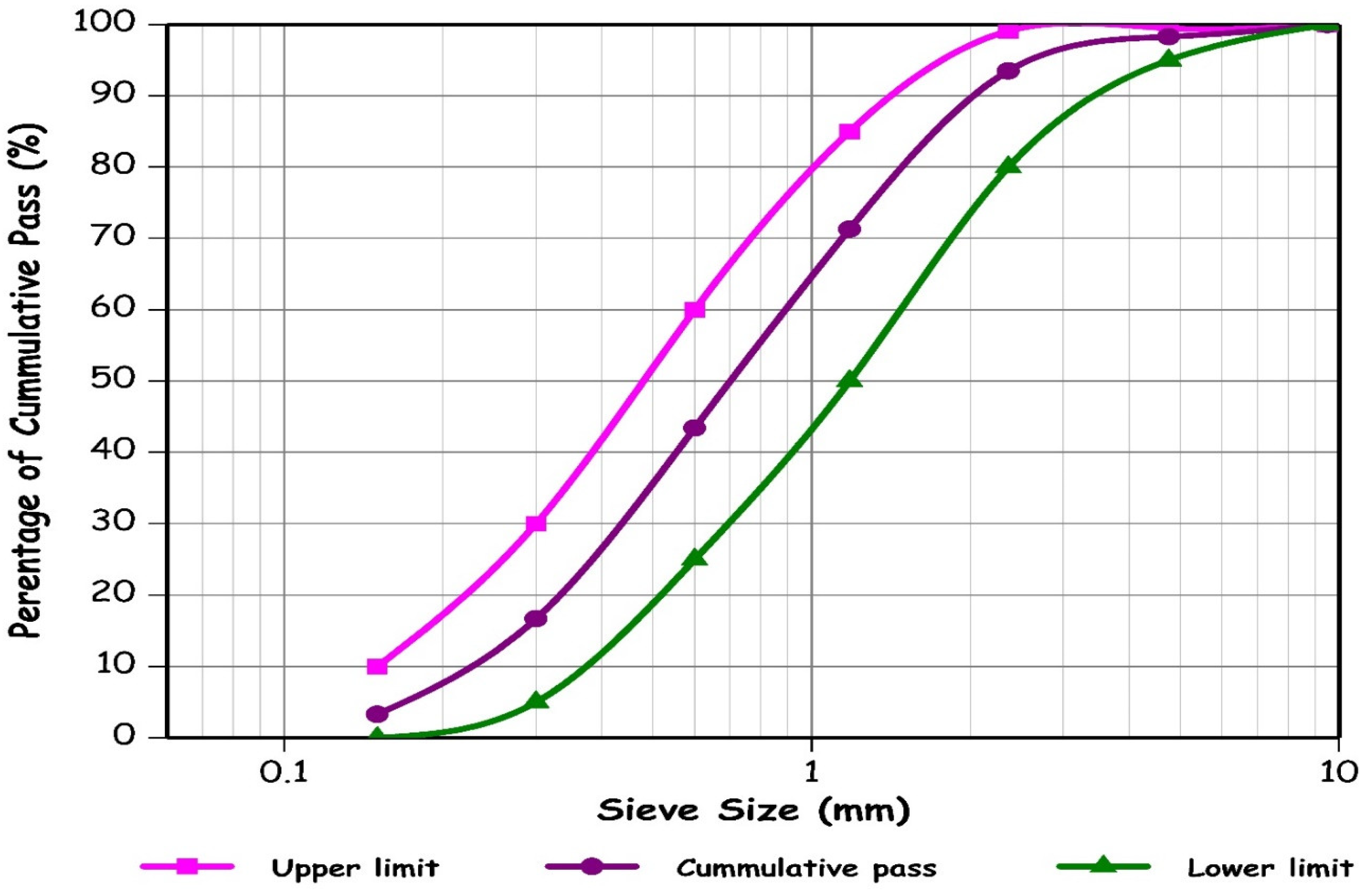
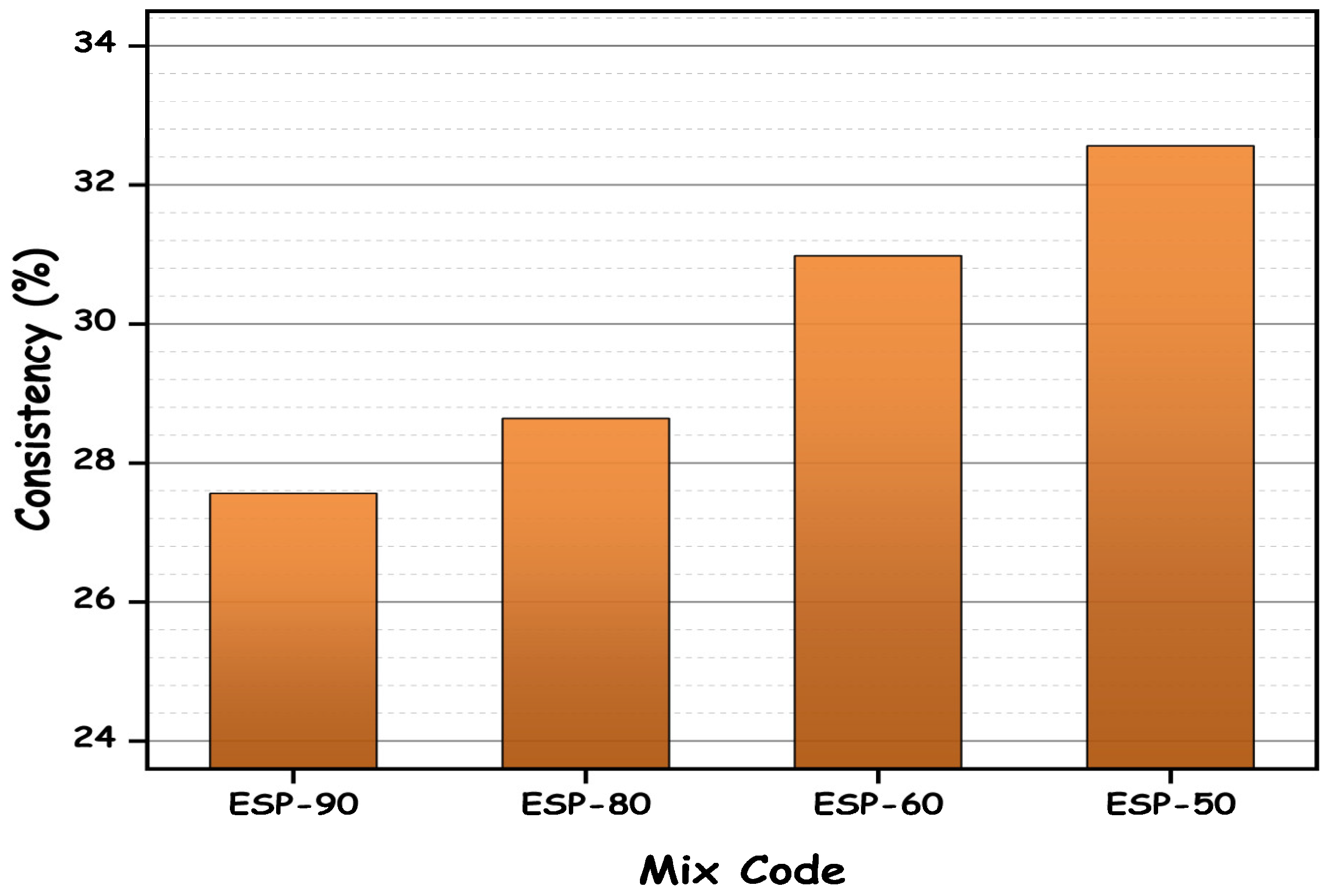
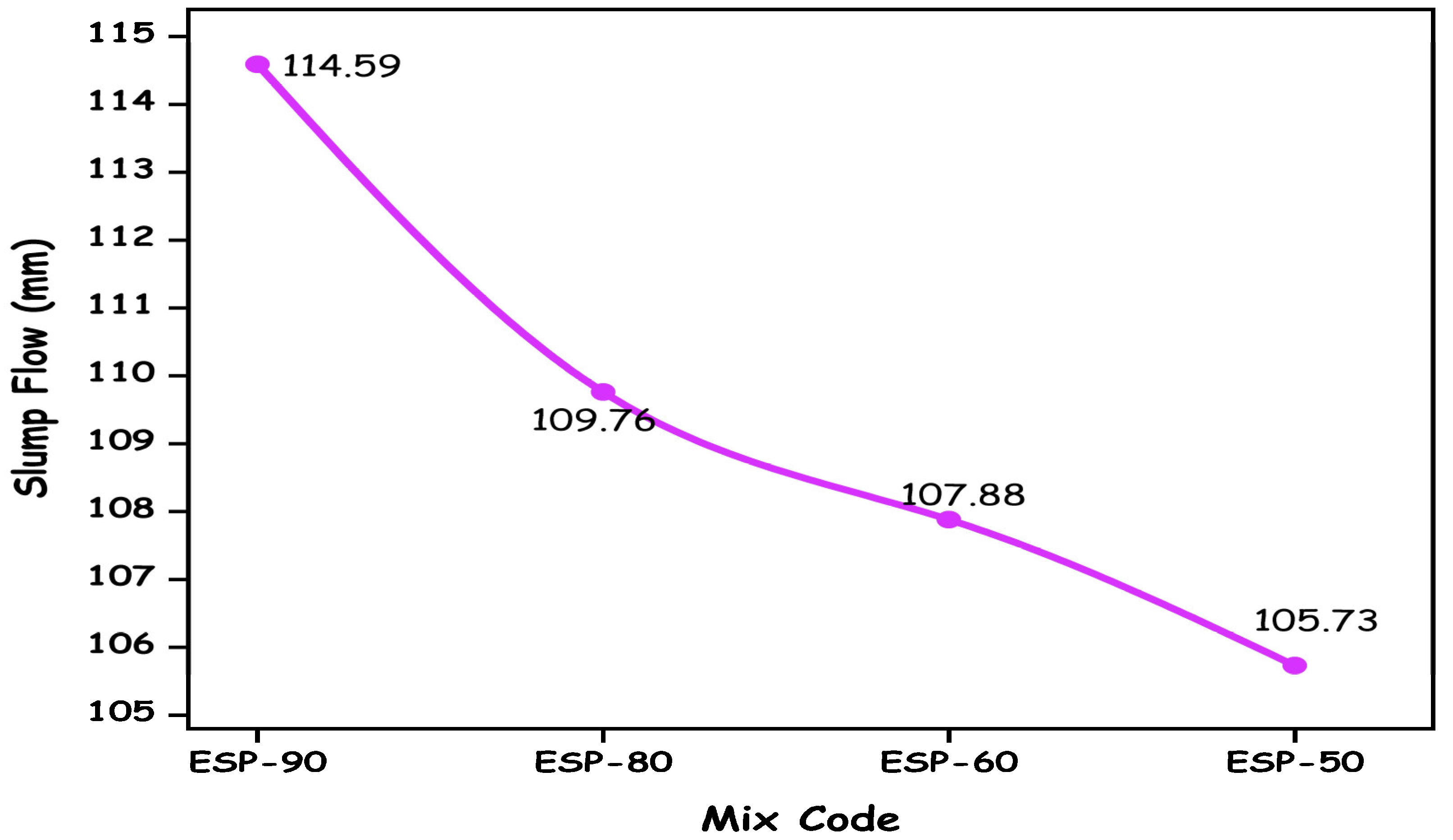
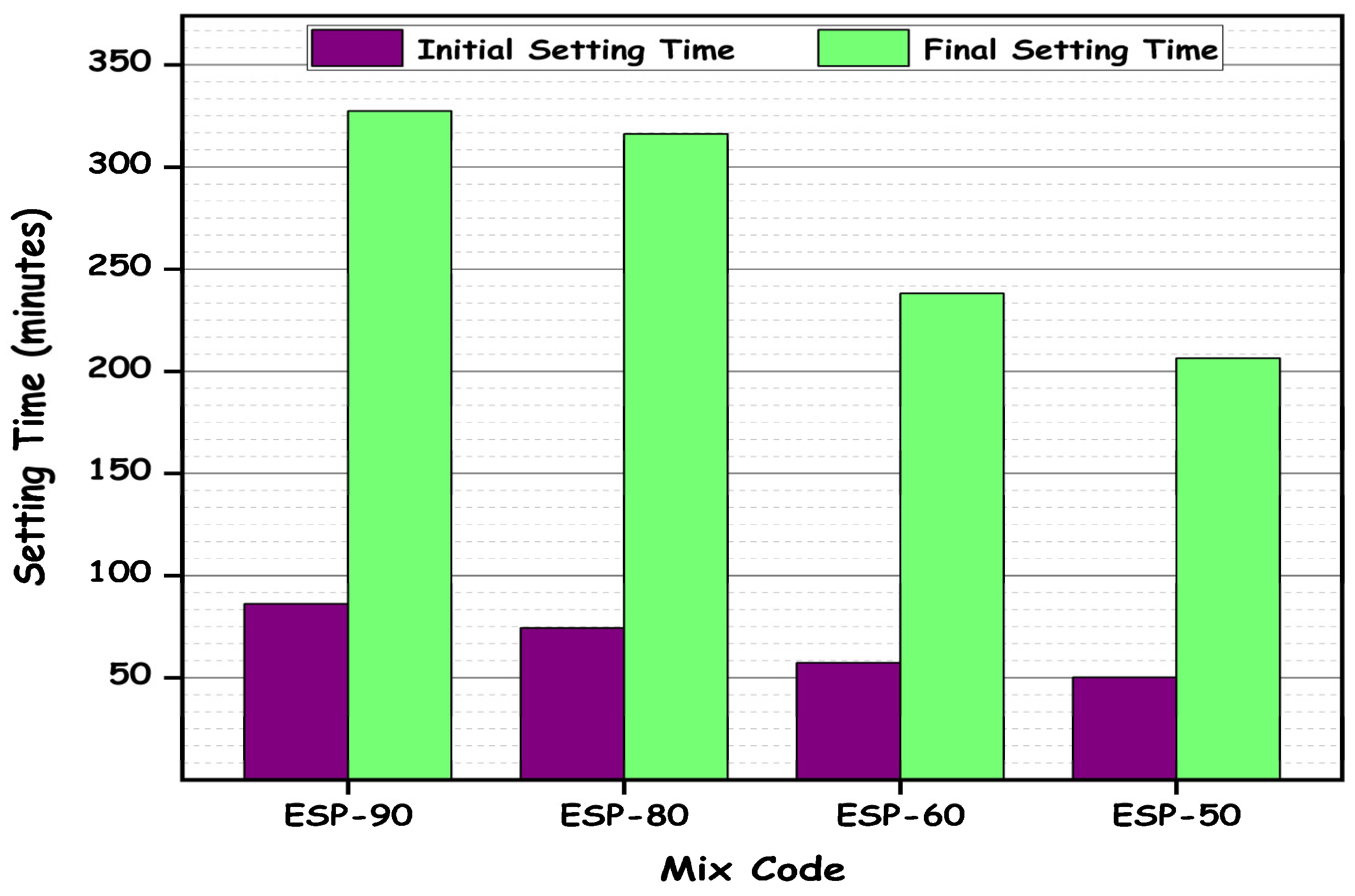
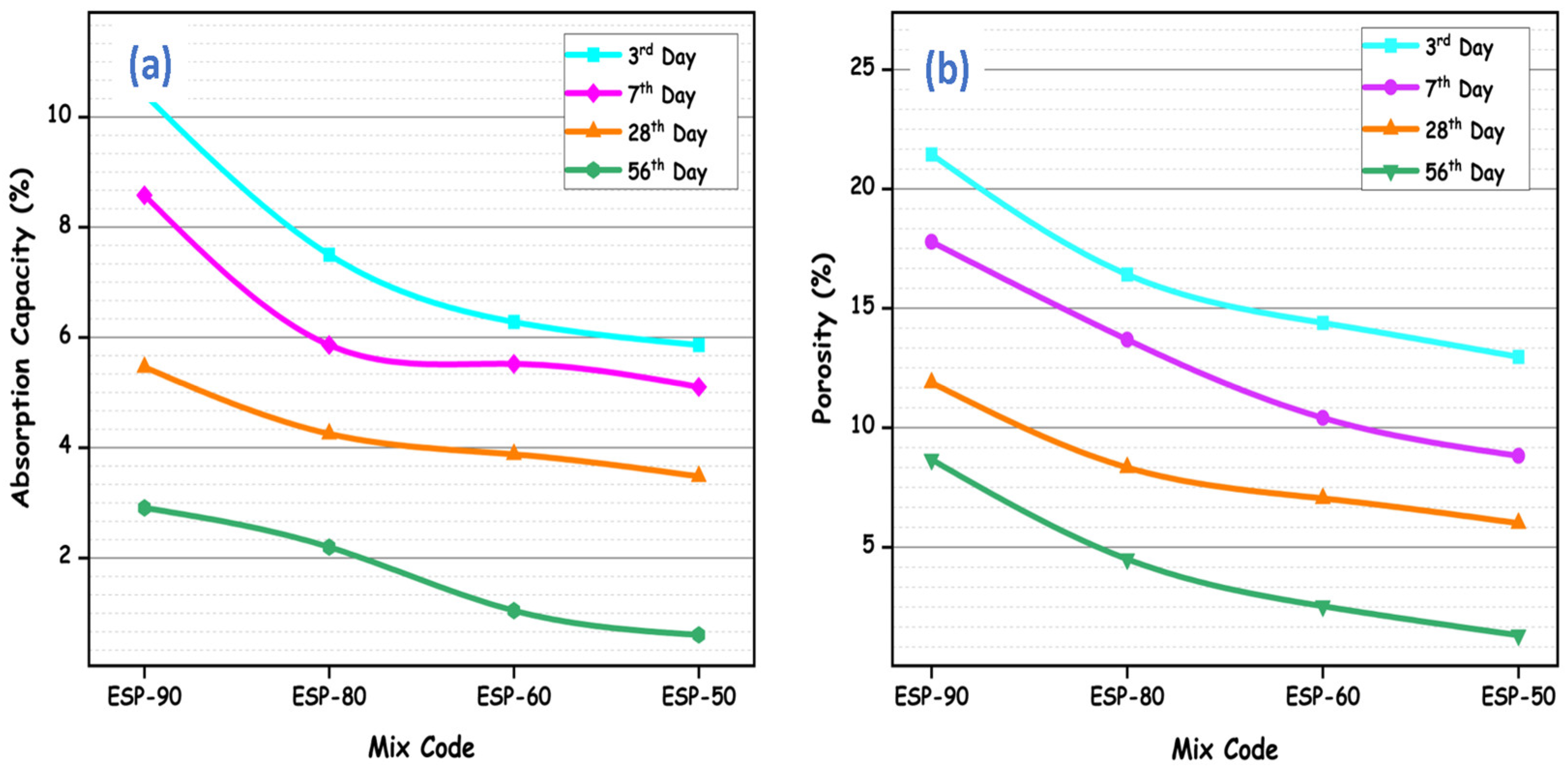
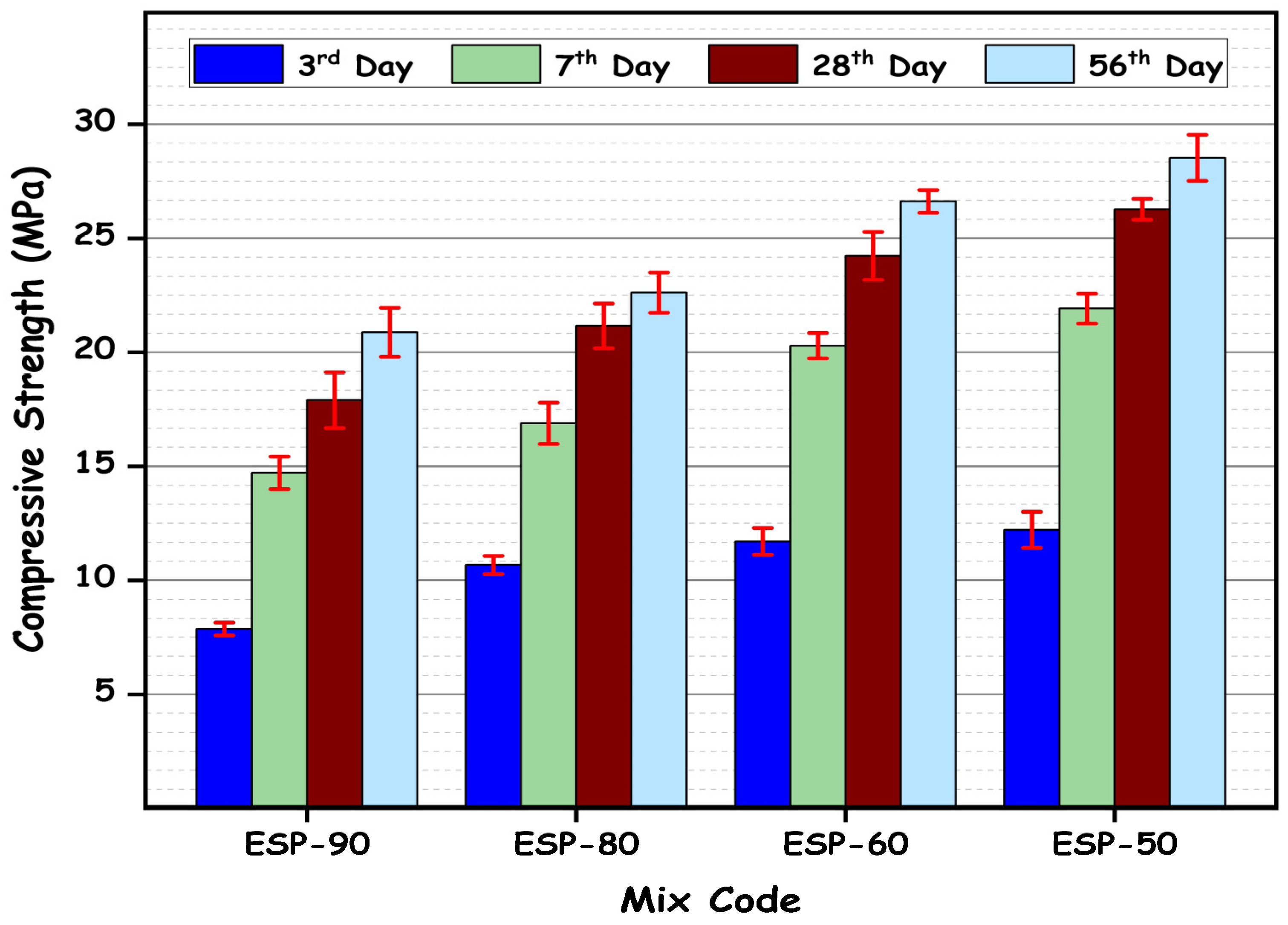




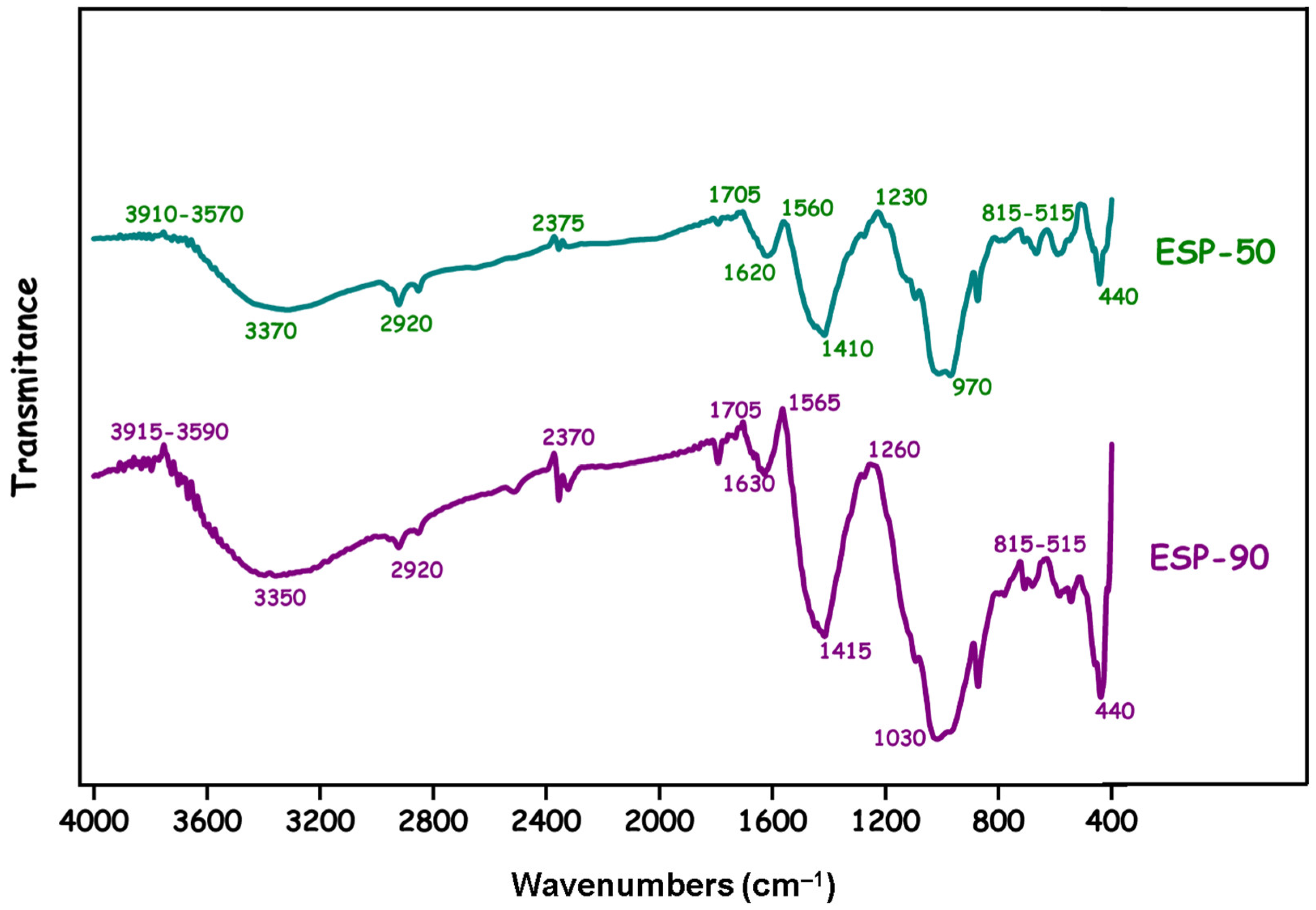
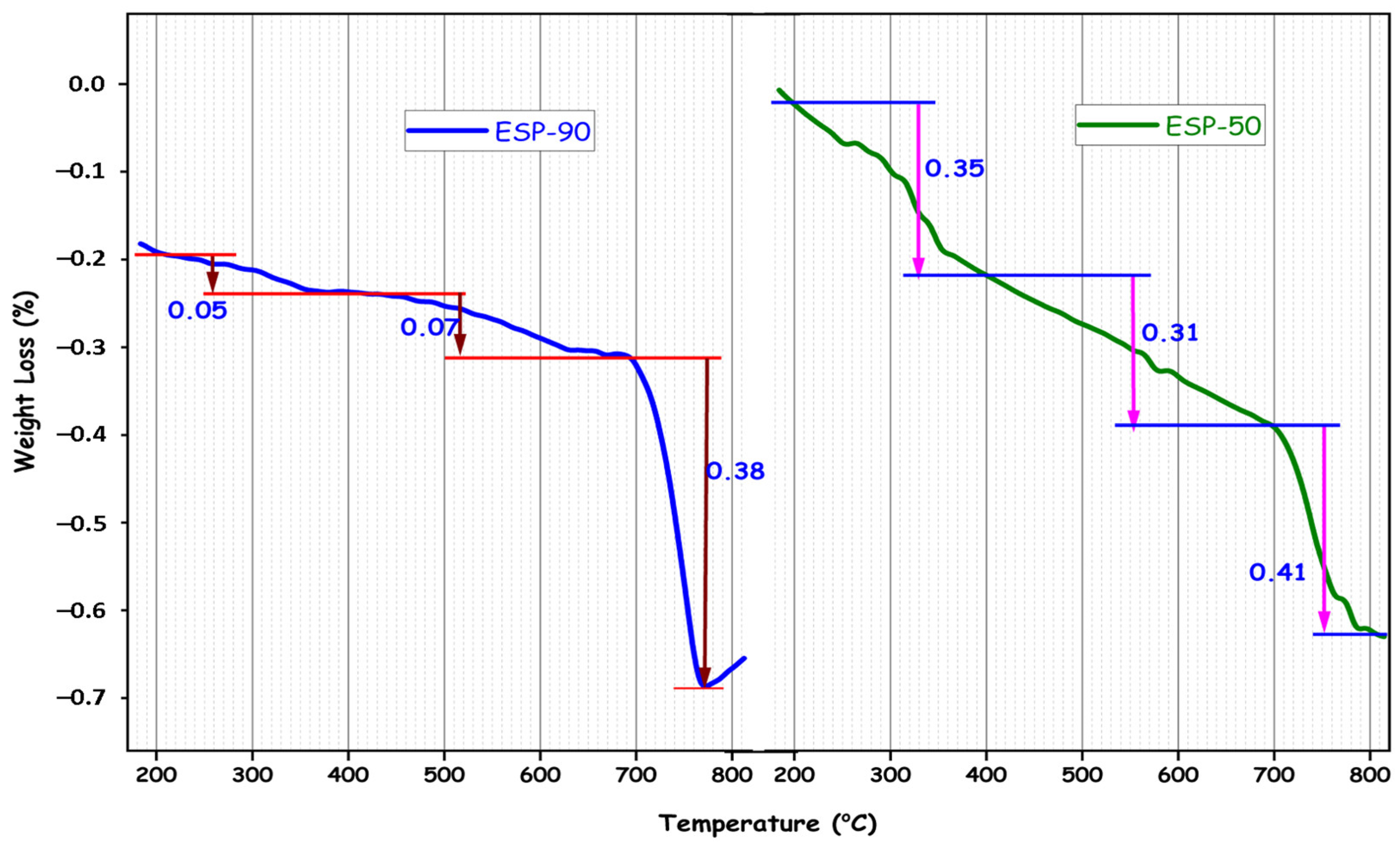
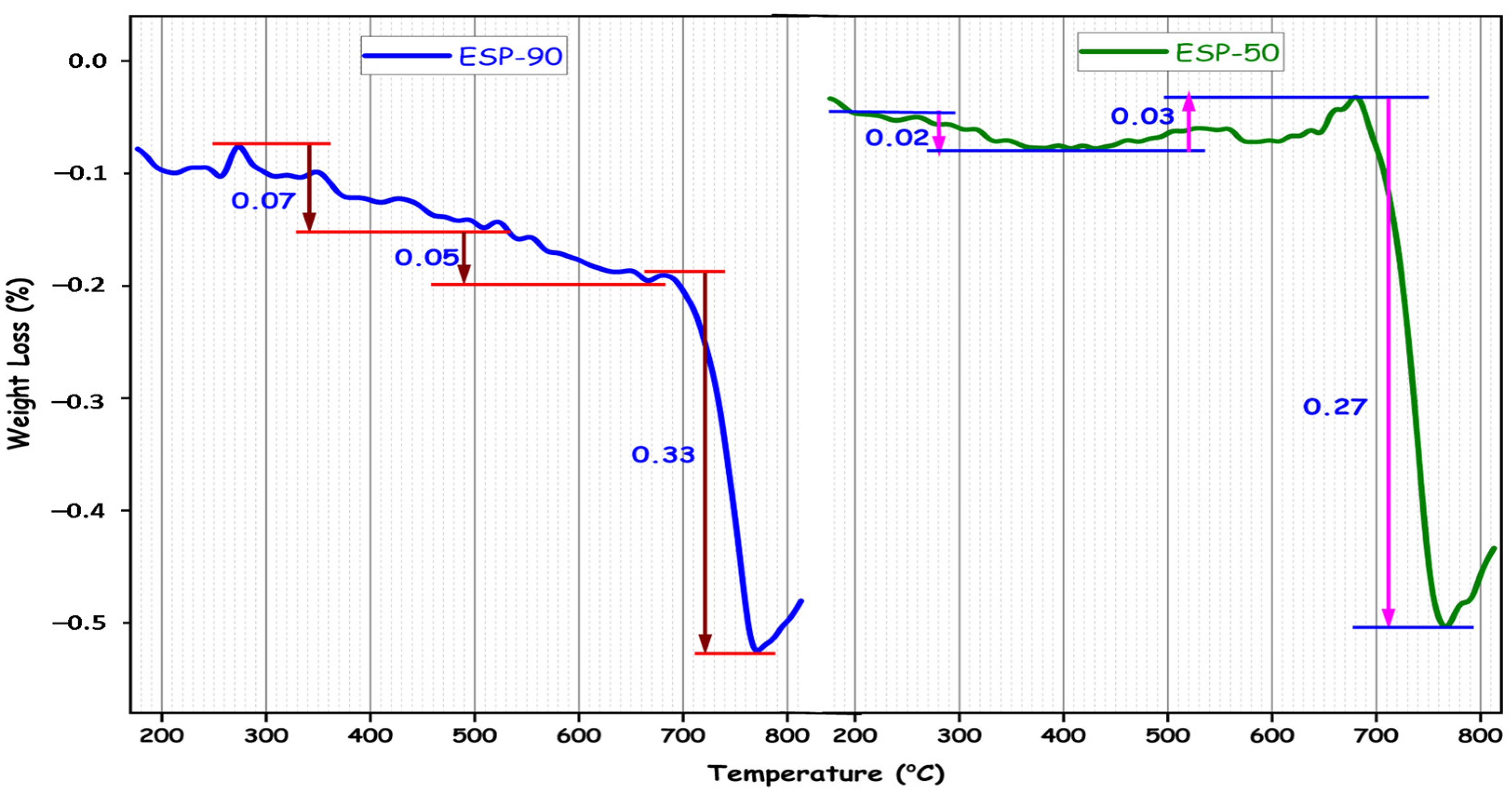

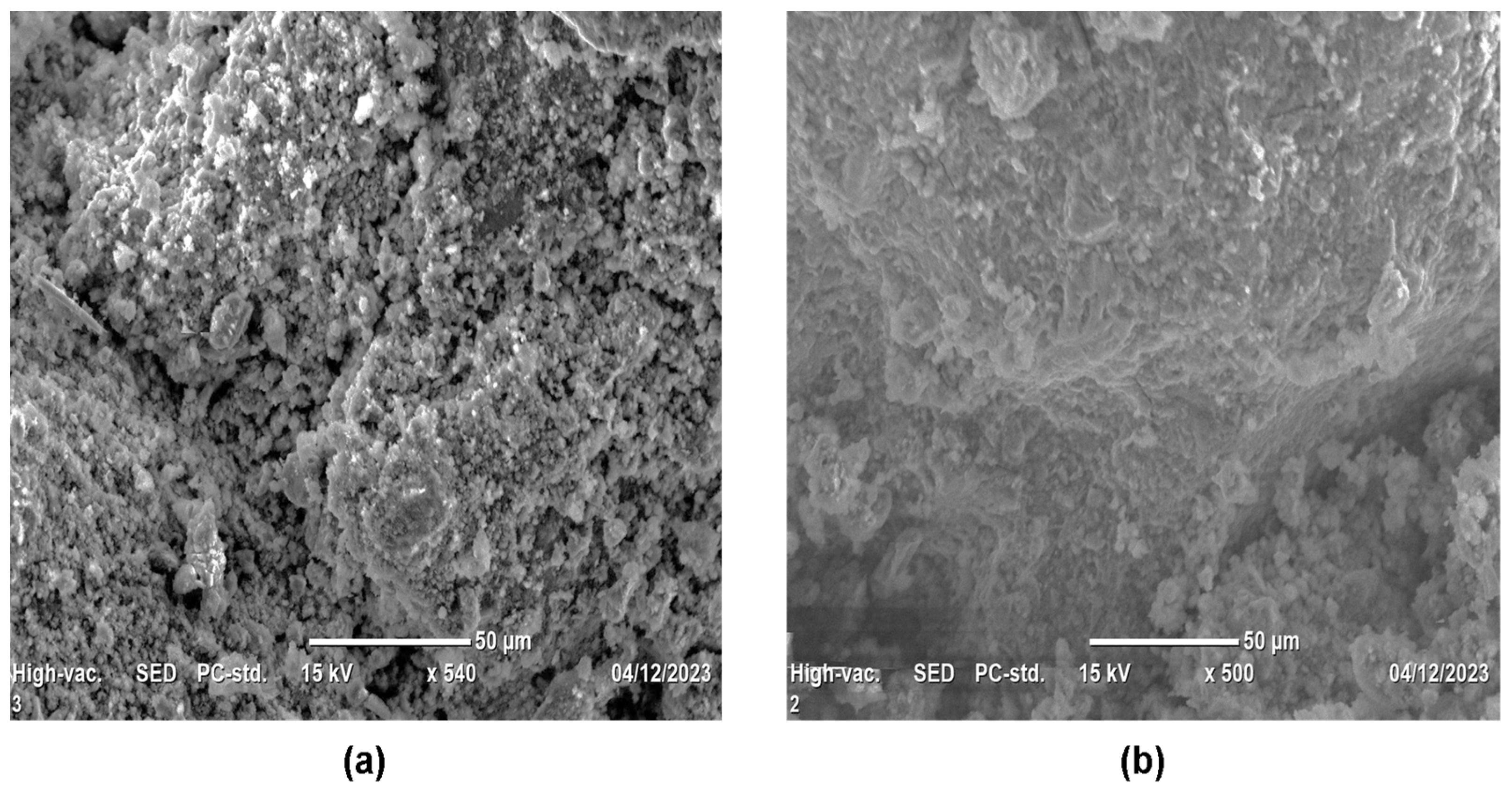
| Binder Compositions and Properties | OPC | ESP | SS | |
|---|---|---|---|---|
| Chemical Compositions, [%] | SiO2 | 22.00 | 3.96 | 5.42 |
| Al2O3 | 5.6 | 1.29 | 2.06 | |
| Fe2O3 | 5.2 | 0.64 | 77.88 | |
| CaO | 64 | 70.40 | 2.17 | |
| MgO | 1.98 | 6.19 | 0.02 | |
| Na2O | - | 0.15 | 0.00 | |
| K2O | - | 0.35 | 0.63 | |
| TiO2 | - | 0.61 | 0.20 | |
| MnO | - | 0.00 | 0.56 | |
| P2O5 | - | 0.17 | 0.52 | |
| LOI | - | 7.54 | 9.93 | |
| Physical Properties | Specific gravity, [–] | 3.15 | 2.62 | 3.48 |
| Surface area, [m2/g] | 318 | 543.51 | 544.22 | |
| Color | Gray | Dark gray | Black | |
| S. No. | Property | Test Method | Unit | Test Result | Acceptable Limit |
|---|---|---|---|---|---|
| 1 | Silt Content | ASTM C40 [48] | [%] | 4.17 | Max., 8 |
| 2 | Absorption or Bulking of Sand | ASTM C128 [49] | [%] | 2.54 | Max., 3 |
| 3 | Fineness Modulus | ASTM C136 [50] | [–] | 2.38 | 2.2–2.6 |
| 4 | Moisture Content | ASTM C566 [51] | [–] | 5.38 | 2–6 |
| 5 | Unit Weight | ASTM C128 [49] | [kg/m3] | 1597 | 1520–1680 |
| 6 | Specific Gravity | ASTM C128 [49] | [–] | 2.64 | 2.50–2.68 |
| Mix Code | Cement Content | ESP Content | Slag Content | NaOH | Na2SiO3 | Water | Sand | |||
|---|---|---|---|---|---|---|---|---|---|---|
| [%] | [kg] | [%] | [kg] | [%] | [kg] | [kg] | [kg] | [lit] | [kg] | |
| ESP-90 | 50 | 283.33 | 90 | 255.00 | 10 | 28.33 | 10.88 | 21.76 | 239.36 | 1558.33 |
| ESP-80 | 50 | 283.33 | 80 | 226.67 | 20 | 56.67 | 10.88 | 21.76 | 239.36 | 1558.33 |
| ESP-60 | 50 | 283.33 | 60 | 170.00 | 40 | 113.33 | 10.88 | 21.76 | 239.36 | 1558.33 |
| ESP-50 | 50 | 283.33 | 50 | 141.67 | 50 | 141.67 | 10.88 | 21.76 | 239.36 | 1558.33 |
| Test Samples | Test Properties | Test Standards | Evaluated Samples | Curing Periods | Number of Cubes Cast |
|---|---|---|---|---|---|
| Fresh Properties | Consistency | ASTM C1437 [56] | All mixes | ||
| Slump | ASTM C187 [57] | – | |||
| Setting time | ASTM C191 [58] | ||||
| Hardened Properties | Bulk density | ASTM C642 [62] | All mixes | 3, 7, 28, 56 days | 5 × 4 × 3 = 60 * |
| Absorption capacity | ASTM C642 [62] | ||||
| Pore space | ASTM C642 [62] | ||||
| Compressive strength | ASTM C109 [60] | ||||
| Uniformity (UPV) | ASTM C597 [61] | ||||
| Sulfate resistance | ASTM C1012 [63] | ||||
| Microstructure | Mineralogical composition (FTIR) | ESP-90, ESP-50 | 7, 28, 56 days | ||
| Thermal stability (TGA) | – | ||||
| SEM analysis | 56 days |
| Mix Code | Bulk Dry Density, kg/m3 | |||
|---|---|---|---|---|
| 3rd Day | 7th Day | 28th Day | 56th Day | |
| ESP-90 | 1519.18 | 1528.80 | 1570.50 | 1586.38 |
| ESP-80 | 1570.42 | 1580.36 | 1610.95 | 1626.47 |
| ESP-60 | 1588.15 | 1608.85 | 1617.15 | 1647.76 |
| ESP-50 | 1605.28 | 1625.34 | 1625.29 | 1660.31 |
| Mix Code | Change in Compressive Strength, MPa | Percentage Loss in Compressive Strength, % | ||||||
|---|---|---|---|---|---|---|---|---|
| 3rd Day | 7th Day | 28th Day | 56th Day | 3rd Day | 7th Day | 28th Day | 56th Day | |
| ESP-90 | 2.09 | 1.99 | 1.62 | 1.45 | 26.54% | 13.52% | 9.05% | 6.95% |
| ESP-80 | 1.79 | 1.55 | 1.37 | 1.28 | 16.74% | 9.19% | 6.49% | 5.64% |
| ESP-60 | 1.67 | 1.48 | 1.17 | 0.90 | 14.24% | 7.28% | 4.83% | 3.38% |
| ESP-50 | 0.81 | 0.64 | 0.39 | 0.20 | 6.65% | 2.91% | 1.49% | 0.69% |
Disclaimer/Publisher’s Note: The statements, opinions and data contained in all publications are solely those of the individual author(s) and contributor(s) and not of MDPI and/or the editor(s). MDPI and/or the editor(s) disclaim responsibility for any injury to people or property resulting from any ideas, methods, instructions or products referred to in the content. |
© 2024 by the authors. Licensee MDPI, Basel, Switzerland. This article is an open access article distributed under the terms and conditions of the Creative Commons Attribution (CC BY) license (https://creativecommons.org/licenses/by/4.0/).
Share and Cite
Hailemariam, B.Z.; Yehualaw, M.D.; Taffese, W.Z.; Vo, D.-H. Optimizing Alkali-Activated Mortars with Steel Slag and Eggshell Powder. Buildings 2024, 14, 2336. https://doi.org/10.3390/buildings14082336
Hailemariam BZ, Yehualaw MD, Taffese WZ, Vo D-H. Optimizing Alkali-Activated Mortars with Steel Slag and Eggshell Powder. Buildings. 2024; 14(8):2336. https://doi.org/10.3390/buildings14082336
Chicago/Turabian StyleHailemariam, Behailu Zerihun, Mitiku Damtie Yehualaw, Woubishet Zewdu Taffese, and Duy-Hai Vo. 2024. "Optimizing Alkali-Activated Mortars with Steel Slag and Eggshell Powder" Buildings 14, no. 8: 2336. https://doi.org/10.3390/buildings14082336







